Juniper Crimean
Content:
Juniper is an evergreen, coniferous, shrub and woody crop from the cypress family. There are about a hundred different varieties around the world. They can decorate any garden that you like, whether it's a limited area or an unimaginably vast one. In this article we will tell you about the "Crimean" variety
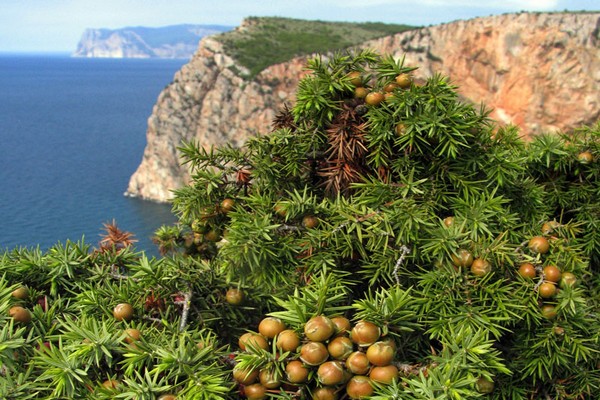
Juniper Crimean: photo
Varieties of the Crimean juniper.
Crimean junipers belong to the cypress genus. In total, there are five units of types:
1) Standard.,
2) Foul smelling.,
3) Kazakh.,
4) Red.,
5) Tree-like.
Presentation of the Crimean junipers.
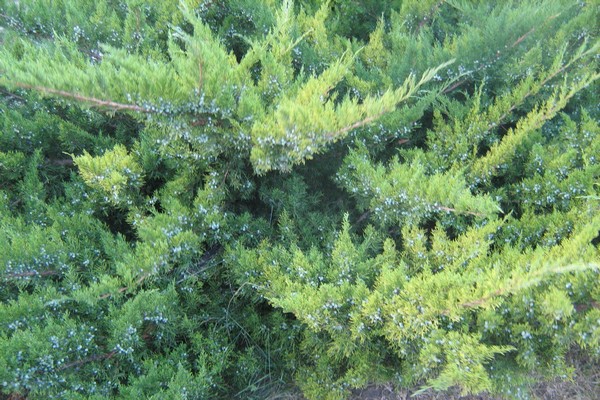
Consider the characteristics of this variety. There are several of them.
These are quite ancient plants.
The word juniper comes from a pair of words, spruce and moss.
Mozha means a strong knot.
Junipers were bred at the beginning of the nineteenth century in the Crimean Botanical Garden.
Now there is a fantastic number of species of Crimean junipers grown abroad.
Stories and photos of more species of Crimean juniper can be viewed on the Internet, just by looking.
Crimean juniper grows on the territory of the Crimean and Kerch peninsulas, as well as on the mountains that are part of the Krasnodar Territory.
This type of juniper is great for heat and is not sensitive to droughts.
You can meet this type of juniper in a mountainous area no higher than one and a half kilometers above sea level.
Crimean juniper grows very slowly, by a couple of centimeters per year.
The average size in appearance is about four meters up.
Leaves, represented by thin needles, and well-groomed needles of spruce.
Red berries can be found on the shoots.
They are inedible and poisonous, so they should never be eaten.
Important. Since the Crimean juniper is in the red book, it is strictly forbidden to cut it down, throughout the Crimea and the city of federal significance - Sevastopol.
The average age of the Crimean juniper is six hundred years.
After reaching the age of two hundred years, the crust begins to crack in parallel lines.
The needles change every five years.
The needles, which are already too old, fall off, after a while, rot and create fertile soil for other plants and the juniper itself.
Flowering begins in early spring, the plants are very light-loving.
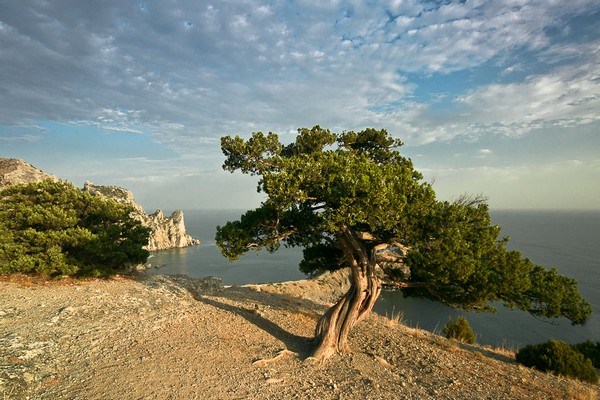
What are the Crimean junipers?
There are about six dozen varieties in total. There are five units of the main types of Crimean juniper. Let's list them:
1) Red.,
2) Foul smelling.,
3) Cossack.,
4) Standard.,
5) Tree-like.
Of these five species, the creeping ones are the "stinker" and the Cossack, they are usually found on the slope of the mountains and resemble a carpet. These five units of the types of juniper are divided according to the type of needles. Creeping needles are hard, while standing needles are soft enough.
Crimean red juniper.
Consider the distinctive features of this representative of this variety.
The first distinguishing feature of this variety.
This species has other names, for example, Spaniard or red cedar, you can also find the name cedar heather.
The second distinguishing feature of this variety.
Typical growth for this variety is around eight meters.
The third distinguishing feature of this variety.
It often happens that people call it a thorn because the plant has very sharp needles.
The fourth distinguishing feature of this variety.
The bark covered with cones is usually red in color.
The fifth distinctive feature of this variety.
Flowering starts in September.
The sixth distinguishing feature of this variety.
But cones do not exist on every juniper, these plants are dicotyledonous, that is, cones can only be on female plants, on males, they are not.
Highest juniper.
Consider the distinctive features of this representative of this variety.
The first distinguishing feature of this variety.
This species has burgundy berries that are found along the main stem.
The second distinguishing feature of this variety.
When reading descriptions of this variety, do not be surprised if it is called spectacular or gorgeous.
The third distinguishing feature of this variety.
This variety attracts the attention of every person passing by.
The fourth distinguishing feature of this variety.
This plant looks like a tree, unlike its counterparts, this is how they attract the eye.
The foul smelling Crimean juniper.
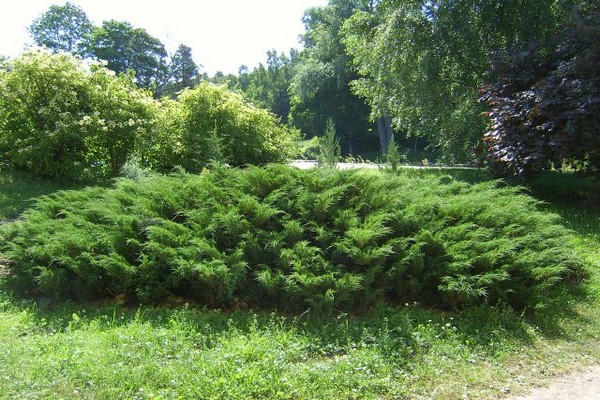
Consider the distinctive features of this representative of this variety.
The first distinguishing feature of this variety.
The cones of this variety are large and not burgundy, but of a black shade; outwardly, the juniper itself outwardly resembles a tree-like Crimean species.
The second distinguishing feature of this variety.
The needles of this juniper also cast a little black.
The third distinguishing feature of this variety.
The name "smelly" juniper got its name precisely because its needles give off an unpleasant odor.
Cossack juniper.
Consider the distinctive features of this representative of this variety.
The first distinguishing feature of this variety.
This is an ornamental plant that has soft needles.
The second distinguishing feature of this variety.
Typically, plants can be seen on mountain peaks, where they spread over the surface.
The third distinguishing feature of this variety.
It is the most common shrub among junipers.
The fourth distinguishing feature of this variety.
It can often be recognized in various household plots, and in parks, as part of a kraft composition, it is used in landscape design.
The fifth distinctive feature of this variety.
This species has about three dozen varieties.
The sixth distinguishing feature of this variety.
As a rule, the height does not exceed two hundred centimeters. The plant grows rapidly in width.
The seventh distinguishing feature of this variety.
The bark changes depending on the age of the plant.
The eighth distinguishing feature of this variety.
In youth, the plants are very prickly, the needles are quite hard.
The ninth distinctive feature of this variety.
With age, they soften and become very soft.
The tenth distinguishing feature of this variety.
It is quite possible to meet this variety in Ukraine, Belarus, Kazakhstan and the Crimean Peninsula.
An ordinary juniper growing in the Crimea.

Consider the distinctive features of this representative of this variety.
The first distinguishing feature of this variety.
This species can be found throughout our country, in the north and in the temperate climatic pole, mainly where there are forests.
The second distinguishing feature of this variety.
The juniper is covered with small dry seedlings.
The third distinguishing feature of this variety.
Interesting.These fruits are used in the preparation of gin. And they are used as a seasoning.
The fourth distinguishing feature of this variety.
It is important, do not forget that only ordinary juniper cones can be used as a tasty addition to dishes, Cossack, for example, is already poisonous to humans.
The fifth distinctive feature of this variety.
It is not recommended to consume more than six units of fruit crops per day.
The sixth distinguishing feature of this variety.
The crown of a plant resembles a pyramid or an egg. The crown looks like a cypress and is green.
Crimean juniper: how does it reproduce?
Most often Crimean junipers multiply using cuttings. If the procedure is carried out correctly, then you can do it almost at any time of the year, best of all in the spring. The roots take root quite easily in the ground in summer and then survive frost well in winter. There are a number of simple rules for the correct reproduction of the Crimean juniper. Consider a few recommendations for breeding this variety.
It is better to prepare cuttings when the weather is cloudy.
Sunlight directly on the sprouts can harm them.
Harm can be inflicted not only on small sprouts, but also on the plant on which the cut remains.
The already slightly woody shoots, which are located at the top of the bush, are best suited.
For each variety of juniper, the method of collecting cuttings is different.
It is recommended to cut the upward branches that are located at the top of the shrub if you have a pyramidal variety of juniper.
If you are the owner of creeping varieties, you are better off giving preference to vertical branches.
If your juniper looks like a bush, then you can use any shoots.
To cause the least damage to the plants, it will be better to use sharpened and disinfected tools.
It is necessary to remove excess needles on the lower five centimeters of the shoot.
It should be planted immediately, since the cuttings cannot be stored.
Cuttings have a maximum shelf life of one hundred and eighty minutes and should be placed in a container of water or wrapped in a damp cloth and placed in a cool place.
But it is not recommended to store cuttings; this can be done only if you do not have time at all.
Ideal for planting is soil that can pass liquid and that is loose enough.
Well, peat or sand is suitable for this.
The above listed elements can be mixed in equal amounts.
Important. Crimean junipers love rather acidic soil, so shells or ash added to the soil will help them grow better.
Landing should be done to a depth of three centimeters in already prepared boxes, in which there is a base of the soil.
The boxes should be located in warm places with average humidity.
It would be better not to put the boxes in direct sunlight, they can cause burns to young plants.
At the beginning of the germination of the plant, good watering is very important.
Watering is best done with water held in the sun.
In order for the moisture to be normal for young plants, you need to spray them with a spray bottle about six times a day.
Watering should be done only when the soil is dry.
The sprouts begin to hatch six dozen days after planting.
It is recommended to keep the sprouts in a greenhouse for a year. If this cannot be done, then transplant should be done very carefully, together, with an earthy clod that remains on the roots.
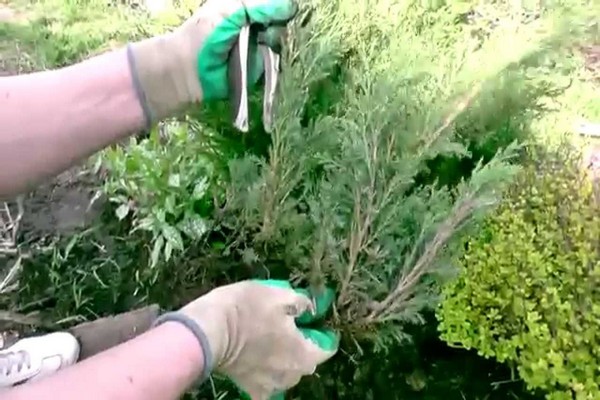
Juniper Crimean: medicinal properties
Consider several options for using this variety as a medicine.
They can be used for disinfection.
Previously, with the help of Crimean junipers, they fumigated rooms where there were sick people or women in labor.
It was also customary to take a steam bath with juniper brooms.Scientists have recognized that Crimean junipers have the highest bactericidal properties among trees. But polluted air is destructive for this species of plants. It is because of this that it is not possible to meet him in big cities.
For many years, these junipers in Crimea were dug up and uprooted to make way for vineyards, nevertheless, they are still alive, and these are very favorable conditions for them. Due to too slow growth, the recovery of junipers takes a very long time. Now the Crimean Juniper is in the Red Book and it is forbidden to do anything with it. On the territory of Crimea, in various shops and kiosks, you can find souvenirs with these ancient and great plants.
In the books, the mention of the fact that the Crimean junipers has healing qualities was recorded at the end of the eighteenth century. After that, junipers were officially registered in state pharmaceuticals.
Crimean junipers were used as a medicine on the territory of ancient Greece and Egypt and the Roman Empire. They were used to apply bandages. Wounds of people were wrapped with bandages, which were pretreated with oil squeezed from juniper, it helped to destroy bacteria and the skin to heal faster.
And in a solution with this oil, instruments were often disinfected.
In America, it was often practiced to place tuberculosis patients in juniper forests, where they were delivered only water and food. Fumigation of the premises, that is, their disinfection, was carried out by setting fire to dried juniper berries.
As it turned out recently, scientists, junipers secrete phytoncides. Thanks to these substances, people in the mountains live for a very long time and enjoy excellent health.
Where can the Crimean juniper be used?
Let's consider several options for using this variety.
In ancient times, tableware was made from juniper wood. It was suitable for long-term storage of food and food did not lose quality to me. When there were no refrigerators, it certainly was used.
In particular, there are not so many junipers left on the territory of Crimea, because they loved to make huts from them.
During the Russian Empire, sugar was often made from juniper berries.
Now, in the twenty-first century, anyone can buy themselves juniper or cypress oil. It helps well in the fight against acute respiratory infections and acute respiratory viral infections, especially in winter, when it is so necessary,
To cleanse the respiratory system during illness, you can prepare a simple solution. Add to the evaporating device two hundred milliliters of warm water mixed with five drops of oil from this beautiful plant.
Often people make a tincture from fresh cone berries.
To make a tincture, you need to wash the buds well with distilled water, place them in two-liter jars and cover them with three hundred grams of sugar. The tincture should be infused for fourteen to fifteen days in a dark place. After insisting, you need to add five hundred milliliters of alcohol. The tincture is ready.
On an industrial scale, cone berries are also used to make syrup for various sweets and jellies.
Oil was also used to enhance the taste of fish in industry.
On the territory of ancient Russia, juniper resin was used as a lubricant in order to process strings in the musical sphere.
We've covered how to use all parts of a juniper except for the roots. The roots were used to make threads. Then they sewed strong sails for various ships, and also tied boards with them and used them for ship ropes.
Conclusion.
Crimean junipers grow very slowly and are quite rare, it is because of this that they are included in the Red Book.But this is a very useful plant, because it has bactericidal properties, it is very often used in medicine and in various other fields, as you yourself could see.

